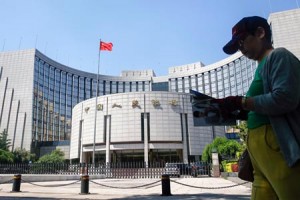As China puts the digital economy and all things data at the heart of the country’s development strategy for the next five years, expanding and regulating the fintech sector in a way that controls risks and avoids the chaos of past few years will be a key part of the initiative.
The People’s Bank of China (PBOC), which oversees the industry, announced on Jan. 4 its roadmap for developing fintech and driving the digital transformation of finance. The four-year plan will have profound implications for how the sector grows over the medium term, for traditional banks and insurers, and for fintech giants such as Ant Group Co. Ltd. and Tencent Holdings Ltd.
 The rapid expansion of fintech companies over the past decade has already changed the country’s financial landscape, with services such as online banking, mobile payments and microlending exploding in an environment of relatively light regulation.
The rapid expansion of fintech companies over the past decade has already changed the country’s financial landscape, with services such as online banking, mobile payments and microlending exploding in an environment of relatively light regulation.
“Fintech is becoming an important engine driving financial reform,” said Wang Shuo, director of innovation at Everbright Technology Co. Ltd., state-owned financial conglomerate China Everbright Group Ltd.’s subsidiary that provides information technology solutions.
“Against this backdrop, the second phase of the plan focuses on solving problems such as unbalanced and insufficient development of fintech, promoting a sound governance system, improving digital infrastructure, and promoting deeper and further integration of finance and technology,” he said.
The Fintech Development Plan (2022-2025) is the second phase of a long-term strategy whose initial goals were mapped out in the first plan covering 2019 to 2021. Among other objectives, the first plan aimed to establish the sector’s overall structure, further boost the application of fintech, and significantly increase the public’s satisfaction with digital financial products and services by 2021.
Now, having built the structure, the PBOC is moving to the next phase of driving fintech growth, giving full play to data and innovation to benefit the economy while also improving regulation to stamp out risk and malfeasance, and ensure that laws on data security and privacy are obeyed. According to the PBOC’s Jan. 4 announcement, the plan will ultimately aim to drive “leapfrog improvement” of the whole sector and its core competitiveness by 2025.
It places heavy emphasis on harnessing the potential of data as a factor of production. This concept was put forward in a document released by the Communist Party’s Central Committee and the State Council in April 2020 and featured prominently in the five-year plan for developing the digital economy released by the government in January.
Main tasks by 2025
Both the PBOC’s fintech plan and the State Council’s digital economy plan flesh out measures to implement the country’s master plan released in March 2021 that mapped out goals for the 2021-2025 five-year plan and longer-term targets and priorities through 2035.
Apart from emphasizing the need to accelerate the digital transformation of commerce, logistics, finance and other service industries, the State Council’s digital economy plan sets out a target to grow the added value of core digital economy industries to 10% of GDP by 2025 from the 2020 level of 7.8%. These core industries include basic software and hardware, core electronic components, key basic materials and their production equipment, according to the plan.
The China Banking and Insurance Regulatory Commission (CBIRC) also issued a guideline on Jan. 17 telling banks and insurers they need to achieve “significant progress” in digital transformation by 2025.
The PBOC’s latest fintech plan follows four principles — the sector should be data and digitally driven, smart and people-oriented, green and low-carbon, fair and inclusive. It highlights issues including a “digital divide” brought about by the application of smart technology, the problem of unbalanced financial development between different regions of the country, the disorderly expansion of some major internet companies into the financial sector, and the “Matthew effect,” a phenomenon where the strong become stronger while the weak get weaker.
Eight main tasks need to be accomplished, according to the full text (link in Chinese) of the 2022 plan which hasn’t been posted on the PBOC website but is available at the website of the Macro Research (Beijing) Institute of Information Technology, a think tank. These are:
- Improve fintech governance
- Fully unleash the potential of data as a factor of production
- Build new digital infrastructure including green data centers and efficient computing system
- Deepen the application of core technologies
- Activate new operation systems, including smart risk control mechanisms
- Make smart financial services even smarter
- Strengthen prudential regulation of fintech
- Lay a solid foundation for sustainable development including training more fintech professionals
Addressing fintech problems
While seen as a key tool to tackle many problems, the use and abuse of data have become a particular area of concern for the government in recent years. Several laws have been passed aimed at protecting the country, organizations and individuals’ data security, including the Cybersecurity Law, which went into effect in 2017, and the Data Security Law and Personal Information Protection Law promulgated in 2021.
The PBOC plan emphasizes the need to “fully unleash the potential of data as a factor of production,” as well as the “orderly sharing” of data, including building privacy-preserving data sharing platforms that can be used among different entities by applying blockchain technologies, as well as a governance system dictating the ownership and usage rules of data.
What market players want to see are more specific rules on data usage and industry standards, said Wang from Everbright Technology. This includes the sharing of accumulated data on blacklisted entities and risky cases where a company or person applies for multiple loans with different lenders.
As a result, one of the main areas of focus for fintech innovation this year, Wang believes, will be the development of privacy-preserving computation techniques, a field of cryptography that aims to create ways for different parties to share, analyze and use data while ensuring privacy, confidentiality and security by maintaining data encryption.
Ensuring data can be used to its maximum potential also involves building the necessary physical infrastructure such as energy-efficient and environmentally friendly data centers and systems for the financial sector, which are highlighted in the PBOC’s plan.
Risk prevention is another major task set out in the 2022 fintech plan, a recognition from past experience that financial innovation can lead to unforeseen consequences and dangers. The plan proposes establishing boundaries for cooperation between financial institutions and digital channels and stepping up supervision to prevent risky products appearing on the market in the name of innovation.
One practice that landed many Chinese regional banks and internet platforms in trouble was the development of “joint lending” (联合贷款) and “loan facilitation” (助贷) models, where banks teamed up with more lightly regulated technology companies to offer loans and outsourced their risk control measures to their partners.
One executive overseeing innovation at a major financial institution told Caixin this increased risks to banks because some small and midsize outsourcing companies hired by banks and insurance companies do not have adequate technological capabilities, employee stability or ethical standards.
Cases emerged where employees at outsourcing companies were caught selling the personal information of customers. From 2015 to 2016, an employee at a company providing services for the Yongzhou branch of China Construction Bank Corp. in Hunan province illegally sold 3,678 personal credit reports to a third-party loan company, a court filing showed.
The need to control risks is likely to mean greater use of regulatory sandboxes to test new products in a controlled environment ringfenced from the wider financial system to assess their risks, according to Wang.
Next frontier
Making finance serve the real economy has been a long-standing mantra of the government, and fintech is seen as a critical tool in driving this strategy, especially in helping small, liquidity-hungry companies access financing.
“Use big data, artificial intelligence and other technologies to capture the deeper financing needs of micro and small enterprises, comprehensively evaluate their status by using business operation, government and financial data, and supply them with customized online credit products,” the PBOC’s 2022 plan says.
So simply developing new fintech applications isn’t enough, they need to be useful in the real world, and improve efficiency and productivity. In its January notice, the CBIRC told financial institutions to develop financial services platforms for businesses in strategic emerging industries such as advanced manufacturing.
As a result, experts have told Caixin, the next wave of fintech applications will involve the provision of services to companies and businesses across a broad range of industries to meet the government’s digital transformation strategy. This could lead to new digital finance platforms for the corporate clients of financial institutions to help coordinate financing across a company’s entire supply chain.
While small and micro loan models such as loans backed by invoices or tax payment data are well-established and standardized, it is very difficult to standardize lending for micro and small enterprises when different industries are involved, Wang said. For example, the demands and risks involved in providing financing for a company in the tourism industry are completely different from those for a company in the steel industry, he said. Banks can use fintech to customize lending for different types of industries and customers, he said.
Some financial institutions are already developing products targeting the entire supply chain of a particular company. Bringing all the suppliers and customers of that company under one umbrella through a fintech application can bring significant benefits to borrowers and the bank itself.
Sichuan XW Bank Corp. Ltd., an internet-only bank backed by Xiaomi Corp., for example, works with China Mobile Ltd.’s upstream and downstream businesses. As part of its service, it provides flexible short-term loans for mobile phone dealers which wouldn’t be available from other banks, Liu Bo, the bank’s vice president, told Caixin.
One executive at a joint-stock bank told Caixin that it has worked with China Mengniu Dairy Co. Ltd., one of the country’s biggest dairy producers, to provide a range of financial services to more than 1,000 farmers who supply milk, including special loans for buying cows and winter feed. All credit and risk assessment processes are done on a closed, mobile operating platform, the person said.
“This type of business requires system customization, followed by training and integration,” the person said. But once the system is up and running, it’s efficient. And for the bank, the biggest benefit is strong customer stickiness, he said.
Challenges for banks
Fintech apps tailored for specific corporate clients are expected to become an increasingly important business for banks, but this is likely to benefit bigger banks at the expense of smaller lenders who don’t have the financial resources or the human capital to develop these types of services.
Caixin spoke to a number of executives at small and midsize banks, who said this kind of digital transformation could be a challenging task for them. It requires top-level design across a bank’s entire operation including different lines of business, internal management, integrating middle and back office operations, as well as setting up an organizational structure that supports the change. To achieve this, they have to set up a fintech development committee, establish a department to lead fintech development and applications, as well as build a team that can support internal incubation and innovation.
Some city and rural commercial banks in the northwest and northeast regions of China are still only taking baby steps in the initial process of upgrading their information systems, a person at a fintech company told Caixin.
Although larger financial institutions may appear better equipped for the task, they can also run into problems if they are not able to respond quickly to changes in the market, a strategy executive at a large financial institution told Caixin.
The systems and mechanisms already in place at large financial institutions are usually less flexible, and they often face major challenges in building an agile and efficient organizational structure suited for digital transformation, the person said. They also struggle to integrate their information systems with various business operations.
Institutional capacity isn’t the only problem for banks. Finding employees with the right fintech skills is also a challenge and the PBOC’s plan highlights the need to train more personnel, a recognition of the shortage. In a survey of senior management of fintech companies across China launched in June by the National Internet Finance Association of China and KPMG China, 86% of 214 respondents reported difficulty finding talent with a combined background in finance and technology.
“Even for large institutions, it is very difficult to find high-standard talents who understand both the technology involved and the business of banking, while having the required breath of vision and depth of experience,” said the source at the large financial institution.
Given all of these challenges, the PBOC’s fintech plan won’t be easy for many financial institutions to carry out.
 “The key is in the implementation, which involves top-level design, organizational structure planning, talent recruitment, and integrating the resources of the entire bank,” Wang from Everbright Technology said. “Digital transformation at small and midsize banks cannot be achieved merely through issuing a plan or a document.”
“The key is in the implementation, which involves top-level design, organizational structure planning, talent recruitment, and integrating the resources of the entire bank,” Wang from Everbright Technology said. “Digital transformation at small and midsize banks cannot be achieved merely through issuing a plan or a document.”
Source: Caixinglobal.com


























